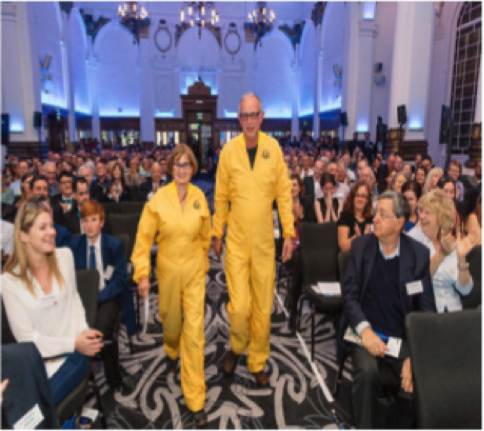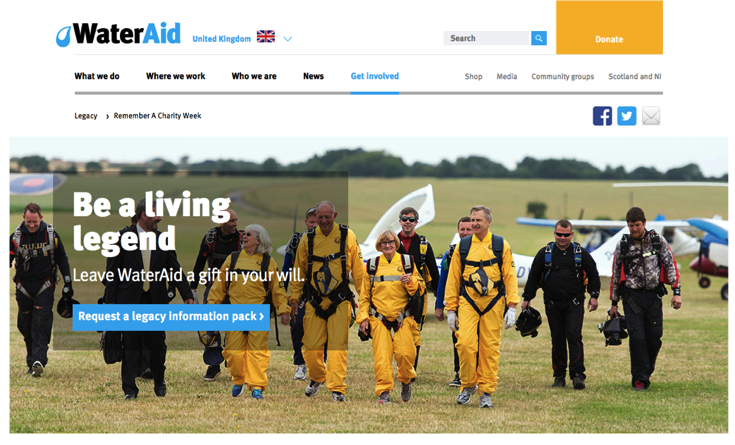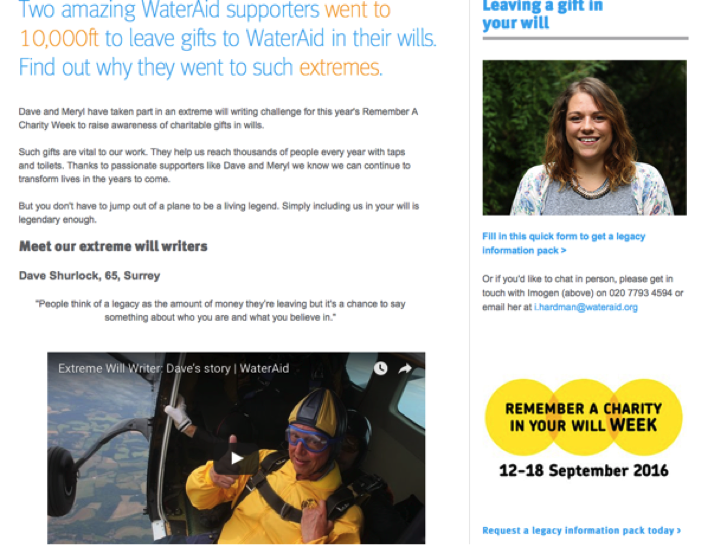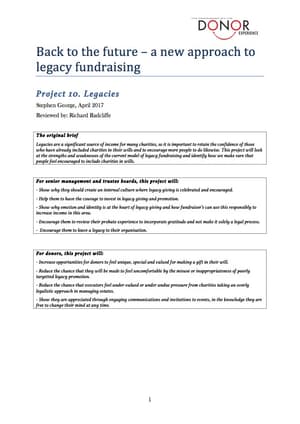CDE project 10 appendix 1: WaterAid
- Written by
- The Commission on the Donor Experience
- Added
- April 19, 2017
WaterAid

This case study was put forward for an Institute of Fundraising Legacy Award and highlights the combination of strategy, marketing and culture to promote legacies in a more donor-friendly way.
WaterAid developed a new legacy marketing strategy at the end of 2014. It recognised that, whilst there had been consistent growth in legacies, it needed to reach a wider audience for this to continue, and the most cost-effective way available was to increase its reach via its existing channels and relationships. It recognised that a step towards change could take place if it helped to normalise the legacy offer for donors and staff alike. Its key aims were:
- Making legacy giving available and accessible for all audiences
- Creating opportunities to engage supporters in a legacy conversation
- Creating a culture at WaterAid in which consideration of legacies are a normal part of the supporter journey
- Developing opportunities to reach other audiences.
As part of this strategy, WaterAid set about training its staff to have a legacy conversation to help to normalise legacies. Staff were trained to understand what legacies were, how to confront their fears (both professionally and personally), to engage with the strategy and to be able have a legacy conversation comfortably. At the heart of this was a core method being driven, namely engagement through conversations.
To support this approach, WaterAid joined the Remember a Charity campaign to access tools to give staff and donors the following opportunities:
- A relevant reason to talk to all audiences about gifts in wills by using the content of the campaign and campaign moments such as the awareness week
- Allow staff, who had been trained in legacy conversations to use the campaign, to practice what they had learned and to engage supporters with the legacy message.
- Focus on discussing legacies while creating consistency of messages and noise around the legacy message to create more impact
- Allow WaterAid to test legacy messages and deliver a donor friendly campaign
- Help embed a legacy culture at WaterAid in which everyone can be involved.
Remember a Charity created a will-writing campaign moment involving volunteers who skydived whole writing wills, called ‘Extreme Will’ writing.
Having two WaterAid volunteers selected for the national campaign meant that WaterAid were able to tailor their stories to each of its audiences to make the legacy ask both relevant and inspiring while overcoming the barriers some fundraising teams had experienced when promoting legacies.
The campaign’s new approach engaged supporters and staff.
- All fundraising teams were asked to promote legacies to their key audiences and relationships, and to practise the legacy conversation skills in which they had been trained
- Two WaterAid supporters were selected to lead the national Remember A Charity Week campaign, giving WaterAid a unique opportunity to share its stories
- More people engaged via email, with an overall email opening rate of 30%, which was 10% higher than the average opening rate. This was achieved because of the nature of the engaging content and story
- A higher conversion of telephone activity, 23.5% versus 20%, was achieved as the callers were able to begin a conversation using a subject that was easy to share and opened the way for a better quality phone conversation
- The legacy webpage normally experienced 2% of web traffic; however, this rose to 17.7% during the campaign.
- Account managers for community volunteers and water industry partnerships became more confident about discussing gifts in wills. In the process of these conversations, they discovered the donors’ intentions and realised that their audiences were interested in legacy giving and continued to talk about legacies throughout and beyond the campaign.
- WaterAid was founded by the UK water industry in 1981, and it still works very closely with the industry. Two companies had legacy roadshows that were launched with a new, free will service that reached 1,500 water industry staff. Other water companies were involved in sharing posters and intranet stories during the week, while Yorkshire Water released a press release about gifts in wills to WaterAid
The first national legacy presentation took place at the annual WaterAid Supporter’s Day, featuring the two skydiving volunteers and reaching 500 key supporters. Stories were at the heart of the approach. The two volunteers who took part in the campaign made a tremendous difference via their personal stories.



With regard to the telephone campaign script, WaterAid tested the sharing of both Dave and Meryl’s stories to see if gender had any uplift on people requesting a legacy pack. They also became community volunteers to promote legacies during their talks.
Overall, the campaign enabled a culture shift to take place, as staff became empowered to engage with legacies, and supporters were engaged in a positive and uplifting style.




















